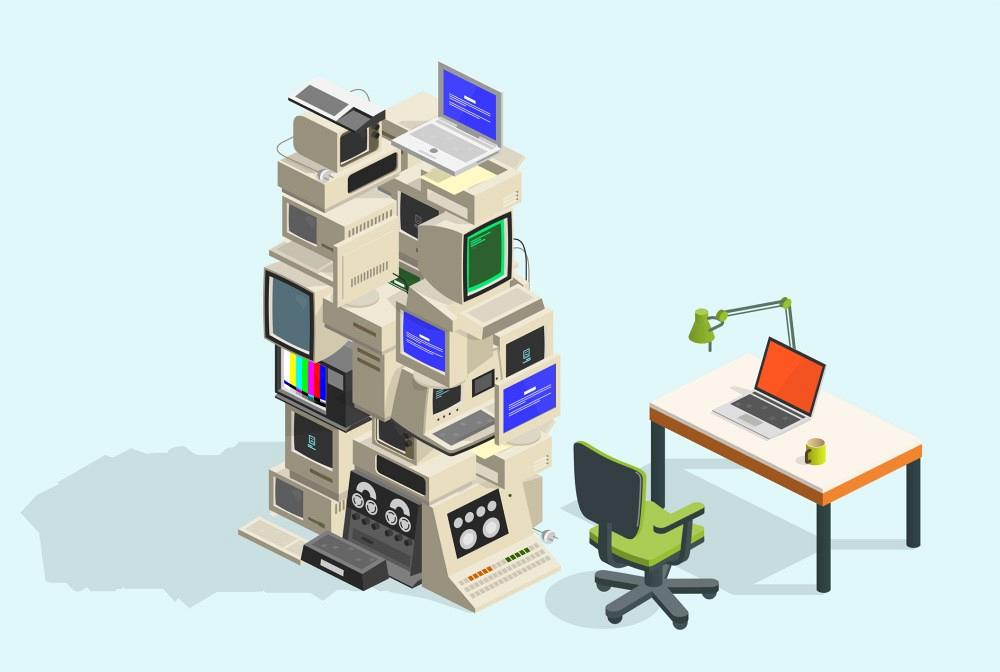CEO/Co-founder
- FMA
- The Fabricator
- FABTECH
- Canadian Metalworking
Categories
- Additive Manufacturing
- Aluminum Welding
- Arc Welding
- Assembly and Joining
- Automation and Robotics
- Bending and Forming
- Consumables
- Cutting and Weld Prep
- Electric Vehicles
- En Español
- Finishing
- Hydroforming
- Laser Cutting
- Laser Welding
- Machining
- Manufacturing Software
- Materials Handling
- Metals/Materials
- Oxyfuel Cutting
- Plasma Cutting
- Power Tools
- Punching and Other Holemaking
- Roll Forming
- Safety
- Sawing
- Shearing
- Shop Management
- Testing and Measuring
- Tube and Pipe Fabrication
- Tube and Pipe Production
- Waterjet Cutting
Industry Directory
Webcasts
Podcasts
FAB 40
Advertise
Subscribe
Account Login
Search
The metal fabrication business, accelerated with tech
How manufacturing technology changed for the better to make the customer experience painless
- By Caleb Chamberlain
- March 19, 2024
When I was 12, my grandma gave me an old 486 IBM-compatible computer. It ran a text-only operating system called DOS, used 5.25-in. floppy disks, and had a green-tinted monochrome display. I don’t recall how much memory or disk space it had, but I still remember the faint buzz of the monitor and the clicking and whirring of the floppy drives. I learned how to program on that machine, writing text adventures in a programming language called BASIC.
As I recall, my grandparents originally purchased the computer to help with my grandpa’s insurance business. It originally cost something like $2,000, equivalent to over $5,000 in 2024. It’s wild to think that such an archaic machine (by today’s standards) cost so much, but it would have been worth it for the “killer app” of early computing: spreadsheets. It probably ran Lotus 1-2-3, an old DOS-based spreadsheet tool that was last updated more than two decades ago.
As clunky as that old software was, it would have transformed the way my grandparents worked. Before personal computers became common in the ʾ80s and ʾ90s, paper ledgers were the name of the game. Bookkeeping was kept in actual books (crazy, I know). And financial projections would have been created laboriously over weeks or months, if at all. In 2024, it’s hard to imagine what it would have been like to run a business without digital spreadsheets. That can be said of many things, and fabrication technology is no exception.
A Room-Sized Monstrosity
My dad, now retired after a long career at a power plant, recently told me a story about the first calculator he ever saw in person: a room-sized monstrosity powered by vacuum tubes and punch cards. He recalled that an operator showed off the machine, bragging about how fast it could multiply numbers. “That was the stupidest thing I ever saw,” he said with a chuckle. Fast-forward to 2024, and modern CNC machines are driven by numerical code generated by computers, from 3D designs produced in CAD software. Machines are controlled by touchscreens, monitored via telemetry, and even serviced remotely, in real time, by technicians on the other side of the planet.
Productivity Multipliers
Computers and software are a force-multiplier on human productivity. I’ve been in the sheet metal business for less than a decade, so I never knew what it was like to calculate bend deductions manually, mark out a blank, cut it with hand tools, then form it on a giant flywheel brake. I’ve seen pictures of those old machines, complete with hand tethers—primitive safety systems that prevented operators from chopping their hands off by literally tying them to a pole.
In our modern shop, our in-house software prepares flat patterns, adjusting bend radii to match tooling and sizing the blank appropriately. A laser cuts the blank with precision. Finally, parts are formed on a precision CNC brake that measures and compensates for material thickness, springback, and other factors to make a near-perfect bend, every time. Computer-driven tools mean that we can make custom parts faster, more accurately, and with less overhead than at any time in history.
That makes our lives easier as fabricators, but it also changes how customers order. Again, I admit that I wasn’t in the industry early enough to see this personally, but an older colleague of mine watched the change throughout his career. “It used to be that shops would have 12 months of regular work booked out, with parts made and then shipped from inventory,” he said. “Then that shifted to six months, then to three. Now, shops might be lucky to have a month of work in the queue at any time. It’s different these days.” He was talking specifically about how it’s hard when you can’t bank on regular work, but I think that trend is positive, driven by tech-enabled efficiency. Modern software makes it easier to communicate, faster to quote, more efficient to change tooling, and more practical to change designs often. Customization and rapid turnaround are the new normal.
No Time to Wait
Customers’ expectations for immediacy are becoming ingrained and widespread. I’ve said this before, but it’s astonishing that young workers today never knew a world without Amazon. Consumers (myself included) expect to get online, order virtually anything, and have it on their doorstep next day. That’s now normal. Considering how things have already changed, it’s beyond clear that this demand for immediacy will continue pushing into manufacturing.
Altogether, this trend is great: Better tools make fabrication easier and more accessible, both for shops and for the customers they serve. That translates to rapid innovation. Companies can design and release new products at an ever-increasing pace, creating value and improving lives like never before.
It also means that for fabricators, “business as usual” isn’t going to cut it. Purchasing agents in their 20s will be frustrated that they have to wait days for pricing. They’ll ask, “What do you mean we have to wait four to six weeks for these parts?” And they’ll gravitate toward manufacturing services that are fast, communicative, and easy to work with. With that in mind, manufacturers need to be asking, “How can I make our service as painless and accessible as possible?”
The answer to that question will vary depending on the customers you serve. Job shops probably need to cut quoting times down from days to hours or less. Off-the-shelf software can help with that. Contract manufacturers might need better cost-tracking software, so that margin drain can be detected and eliminated. Paperless production management systems might reduce confusion and make lead times more predictable, improving the customer experience.
Scheduling automation might optimize production planning and reduce lead times. Meanwhile, modern equipment might decrease production time, increase quality, reduce changeover time, and eliminate programming overhead—all good things that, again, ultimately improve the customer experience.
If recent history teaches us anything, it’s that tech can transform the way we do business, and for the better. New technologies might at first seem impractical and clunky: a room-sized calculator might have seemed like a joke in its day, but imagine going back to a world without digital spreadsheets, CNC machines, email, or the internet! It’s hard to imagine where exactly technology will take us in the coming decades, but we can be sure that manufacturing will be faster, easier, more efficient, and more accessible. If we focus on tech that helps us get there, we won’t go wrong.
The “Amazon generation” CEO: Your order has shipped
As a 20-something reporter, I sat in a fabricator CEO’s office, hearing the ca-chunk of a punch press. His eyes brightened, and his gray hair tussled a bit as he looked out the window to the shop floor below. He gave a subtle smile. “That’s printing money.”
The shop certainly had plenty of money—that is, inventory—on the floor. Something was amiss, though. The CEO looked tired. This was 2002. The transition toward globalization was in full force. He had umpteen friends lose their jobs over the past decade, and his shop no longer had a huge backlog, so job security at his own operation wasn’t what it used to be. Order sizes were starting to get smaller.
To get ahead, the shop would punch extra parts—a lot of extra parts. The brake operators needed tryout parts to scrap, and building an inventory buffer would free capacity for new work, right? Besides, changeovers took forever. That’s why the CEO smiled as the machine started to punch. Finally, money was being made.
How times have changed. Now I have the gray hair, and I rarely hear sources (especially those without gray hair) talk about machines “printing money.” Machine uptime matters to them, but only when put in a larger context. They don’t ask, “How fast can this cut?” Instead, they ask, “How fast can we ship this order?”
These new CEOs are looking at all technology—new machines as well as new kinds of software. Above all else, they want visibility. A machine that’s running isn’t a reason to celebrate. It’s expending energy and resources, after all. Instead, “Amazon generation” CEOs smile when they open a laptop or tablet, review production in real time, and see that everything is moving forward and shipping to the customer as planned. In this way, they’re more in tune with Taiichi Ohno and the roots of lean manufacturing. Machines might be running, but what about all those piles of WIP? As Ohno said, “Sleeping parts make no money.”
This makes perfect sense, really. Again, they grew up with Amazon. They take two-day shipping for granted, four-week lead times feel like an eternity, and even a lengthy order backlog might seem foreign. They don’t remember a day before emails, text messages, and, of course, those Amazon-notification dopamine hits: Your order has shipped!
—Tim Heston, Senior Editor
subscribe now

The Fabricator is North America's leading magazine for the metal forming and fabricating industry. The magazine delivers the news, technical articles, and case histories that enable fabricators to do their jobs more efficiently. The Fabricator has served the industry since 1970.
start your free subscriptionAbout the Author

Caleb Chamberlain
165 N. 1330 W #C4
Orem, UT 84057
801-850-7584
- Stay connected from anywhere

Easily access valuable industry resources now with full access to the digital edition of The Fabricator.

Easily access valuable industry resources now with full access to the digital edition of The Welder.

Easily access valuable industry resources now with full access to the digital edition of The Tube and Pipe Journal.
- Podcasting
- Podcast:
- The Fabricator Podcast
- Published:
- 04/16/2024
- Running Time:
- 63:29
In this episode of The Fabricator Podcast, Caleb Chamberlain, co-founder and CEO of OSH Cut, discusses his company’s...
- Industry Events
16th Annual Safety Conference
- April 30 - May 1, 2024
- Elgin,
Pipe and Tube Conference
- May 21 - 22, 2024
- Omaha, NE
World-Class Roll Forming Workshop
- June 5 - 6, 2024
- Louisville, KY
Advanced Laser Application Workshop
- June 25 - 27, 2024
- Novi, MI
































